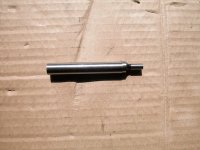Testing, testing, 1,2,3
I've been using wigglers and edge finders for 30 or more years with "good enough for todays job" results but this thread reminded me that I've never actually properly looked at accuracy and repeatability. Despite frequently saying that I'm convinced that the Huffam is the best and most consistent I haven't actually got figures to back it up. So I set them up in an Albretch chuck on the Bridgeport and spent an hour this morning taking readings off the ends of a 1-2-3 block from the 5 micron resolution DRO set-up with slightly surprising results.
Bottom line is I do get best results from the Huffam but the inexpensive collet set isn't as bad as I remember. Maybe a couple of decades or more practice with the Huffam has helped me get better results from the low end one.
I compared the average and scatter over 10 readings for my metric Huffam, a shop made metric Huffam copy, my old mid range collet style wiggler and a mid range edge finder at both 100 rpm and 1,000 rpm. I usually use the Huffam at 100 rpm because its easier to see the moment it starts to walk sideways. When using the Huffam at low speed to find the centre of a part errors cancel out very well indeed making DRO resolution the limiting factor. Assuming that both ends are properly smooth and clean of course.
Bit different if you are trying to measure a single side position of course.
The long side of that 1-2-3 block measures 76.10 mm. I set it up aligned on the X axis of the Bridgeport, used the Huffam to find the centre and set the DRO to zero. So the test edge was at 38.05 mm on the DRO.
The The Huffam ball end is dead on 5 mm Ø according to my M&W micrometer calibrated of a Weber gauge block. Average DRO reading was 40.525 ± 0.015 mm giving an edge position of 38.025 ± 0.015. Subjectively less scatter at 100 rpm.
The shop made copy ball end was also dead on 5 mm Ø. Average DRO reading was 40.500 ± 0.020 giving an edge position of 38.000 ± 0.020. Subjectively less scatter when run at 1,000 rpm. The shop made copy is a little stiffer in the pivot than the real Huffam.
The mid range brand wiggler has a 1/4" nominal diameter ball which measures 6.32 mm. Average DRO reading at 1,000 rpm was 41.245 ± 0.025 and 41.220 ± 0.060 at 100 rpm giving edge positions of 38.085 ± 0.025 and 38.060 ± 0.060 respectively. The collet pivot was much stiffer than the Huffam style which presumably is the reason for the greater intrinsic error. Quite hard to use when run slow but at 1,000 rpm the sideways kick is quite violent. Much more scatter than the Huffam style.
The normal edge finder end is 5.075 mm Ø. Average reading at kick was 40.545 ± 0.015 giving an edge position of 38.013 ± 0.015.
Both Huffam style and edge finder are clearly accurate enough to run into issues with DRO resolution, surface finish and general cleanliness. Best to do tell me three times process if you need accurate but one reading is pretty reliable.
The collet type clearly has greater intrinsic error but, with care its still pretty good. If you take 5 readings you can be pretty sure of results sufficiently reliable to subtract intrinsic error.
DRO digital numbers are slightly silly but it looks like the Huffam claims of finding an edge to 1 thou or so is realistic given reasonable care. Would need to have set-up one of my Heidenhain probes to get scientific level results but that's hardly shop realistic.
Clive




.
Picture order Huffam, Huffam copy, collet style and edge finder.






